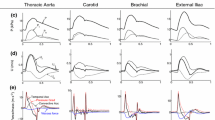Abstract
Wave intensity analysis applies methods first used to study gas dynamics to cardiovascular haemodynamics. It is based on the method of characteristics solution of the 1-D equations derived from the conservation of mass and momentum in elastic vessels. The measured waveforms of pressure P and velocity U are described as the summation of successive wavefronts that propagate forward and backward through the vessels with magnitudes dP ± and dU ±. The net wave intensity dPdU is the flux of energy per unit area carried by the wavefronts. It is positive for forward waves and negative for backward waves, providing a convenient tool for quantifying the timing, direction and magnitude of waves. Two methods, the PU-loop and the sum of squares, are given for calculating the wave speed c from simultaneous measurements of P and U at a single location. Given c, it is possible to separate the waveforms into their forward and backward components. Finally, the reservoir-wave hypothesis that the arterial and venous pressure can be conveniently thought of as the sum of a reservoir pressure arising from the total compliance of the vessels (the Windkessel effect) and the pressure associated with the waves is discussed.







Similar content being viewed by others
Notes
The material in this paper form the basis for a web site An Introduction to Wave Intensity Analysis http://www.bg.ic.ac.uk/research/intro_to_wia. The site contains some additional material and a number of examples which could not be included in this work for reasons of space.
The elemental wavefronts should not be confused with solitons, which are solitary wave solutions of the nonlinear Korteweg–de Vries equation originally derived to model shallow water hydrodynamics. The soliton is another example of a solitary wave that cannot be analysed easily using Fourier methods although it can be described easily as successive wavefronts.
In this case, they are generally referred to as Riemann invariants.
References
Aguado-Sierra J, Alastruey J, Wang J-J, Hadjiloizou N, Davies J, Parker KH (2007) Separation of the reservoir and wave pressure and velocity from measurements at an arbitrary location in arteries. J Eng Med (Proc Inst Mech Eng Part H) 222:403–416. ISSN: 0954-4119
Bramwell JC, Hill AV (1922) The velocity of the pulse wave in man. Proc R Soc Lond B 93:298–306
Euler L (1775) Principia pro motu sanguinis per arterias determinando. In: Fuss PH, Fuss Petropoli N (eds) Opera posthuma mathematica et physica anno 1844 detecta, vol 2. Apund Eggers et Socios, pp 814–823
Franke VE, Parker KH, Wee LY, Fisk NM, Sherwin SJ (2003) Time domain computational modelling of 1D arterial networks in monochorionic placentas. ESAIM Math Model Numer 37:557–580
Kolyva C, Spaan JAE, Pick JJ, Siebes M (2008) “Windkesselness” of coronary arteries hampers assessment of human coronary wave speed by single-point technique. Am J Physiol Heart Circ Physiol 295(2):H482–H490
Matthys KS, Alastruey J, Peiró J, Khir AW, Segers P, Verdonck PR, Parker KH, Sherwin SJ (2007) Pulse wave propagation in a model human arterial network: assessment of 1-D numerical simulations against in vitro measurements. J Biomech 40:3476–3486
McDonald DA (1974) Blood flow in arteries, 2nd edn. Edward Arnold, London
Milnor WR (1989) Hemodynamics, 2nd edn. Williams & Wilkins, Baltimore
Nichols WW, O’Rourke MF (2005) McDonald’s blood flow in arteries: theoretical, experimental and clinical principles, 5th edn. Hodder Arnold, London
Ohte N, Narita H, Sugawara M, Niki K, Lkada T, Harada A, Hayano J, Kimura G (2003) Clincal usefulness of carotid arterial wave intensity in assessing left ventricular systolic and early diastolic performance. Heart Vessels 18:107–111
Papageorgiou GL, Jones NB, Redding VJ, Hudson N (1990) The area ratio of normal arterial junctions and its implications in pulse wave. Cardiovasc Res 6:478–484
Parker KH, Jones CJH (1990) Forward and backward running waves in the arteries: analysis using the method of characteristics. J Biomech Eng 112:322–326
Peterson LH, Shepard EW (1955) Symposium on applied physiology in modern surgery: some relationships of blood pressure to cardiovascular system. Surg Clin North Am 35:1613–1628
Press WH, Flannery BP, Teukolsky SA, Vetterling WT (2002) Numerical recipes in C++ : the art of scientific computing, 2nd edn. Cambridge University Press, Cambridge
Pythoud F, Stergiopulos N, Meister J-J (1996) Separation of arterial pressure waves into their forward and backward running components. J Biomech Eng 118:295–301
Riemann GFB (1859) Üeber die Fortzflanzung ebener Luftwellen von endlicher Schwingungsweite. Gesammelte mathematische Werke und wissenschaftlcher. Nachlass. Liepzig, Teubner BG (ed), pp 145–176 (originally published in Bande VIII, Abhandlungen der Königlechen Geselschaft der Wissenschaften zu Göttingen, pp 43–65)
Siebes M, Kolyva C, Piek JJ, Spaan JA (2009) Potential and limitations of wave intensity analysis in coronary arteries. Med Biol Eng Comput (this issue)
Tyberg JY, Davies JE, Wang Z, Whitelaw WA, Flewitt JA, Shrive NG, Francis DP, Hughes AD, Parker KH, Wang J-J (2009) Wave intensity analysis and the development of the reservoir-wave approach. Med Biol Eng Comput (this issue)
van den Bos GC, Westerhof N, Wlzinga G, Sipkema P (1976) Reflections in the systemic arterial system: effects of aortic and carotid occlusion. Cardiovasc Res 10:565–573
Wang JJ, O’Brien AB, Shrive NG, Parker KH, Tyberg JV (2003) Time-domain representation of ventricular-arterial coupling as a windkessel and wave system. Am J Physiol Heart Circ Physiol 284:H1358–H1368
Wang JJ, Flewitt JA, Shrive NG, Parker KH, Tyberg JV (2006) Systemic venous circulation. Waves propagating on a windkessel: relation of arterial and venous windkessels to systemic vascular resistance. Am J Physiol Heart Circ Physiol 290:H154–H162
Westerhof N, Elzinga G, Sipkema P (1972) Forward and backward waves in the arterial system. Cardiovasc Res 6:648–656
Author information
Authors and Affiliations
Corresponding author
Rights and permissions
About this article
Cite this article
Parker, K.H. An introduction to wave intensity analysis. Med Biol Eng Comput 47, 175–188 (2009). https://doi.org/10.1007/s11517-009-0439-y
Received:
Accepted:
Published:
Issue Date:
DOI: https://doi.org/10.1007/s11517-009-0439-y




